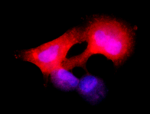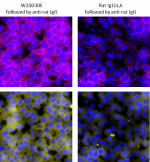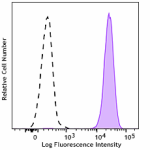- Clone
- W20030E (See other available formats)
- Regulatory Status
- RUO
- Other Names
- Carcinoembryonic antigen-related cell adhesion molecule 6
- Isotype
- Rat IgG2a, κ
- Ave. Rating
- Submit a Review
- Product Citations
- publications

-

The human lung adenocarcinoma cell line A549 was grown on 96-well plates with coverslip bottom and were fixed with Fixation Buffer (Cat. No. 420801) for 30 minutes. Cells were washed twice with PBS and stained with 5 µg/mL Ultra-LEAF™ purified anti-human CD66c (clone W20030E) followed by Alexa Fluor® 555 anti-rat IgG (red) (Cat. No. 405420). Nuclei were counterstained with DAPI (blue) (Cat. No. 422801). Cells were imaged using a 40X objective. -

Human peripheral blood granulocytes were stained with Ultra-LEAF™ purified anti-human CD66c (clone W20030E) (filled histogram) or rat IgG2a, κ isotype control (open histogram) followed by anti-rat IgG PE. -

The effect of clone W20030E to induce CD66c signaling by cross-linking was tested on the human lung adenocarcinoma cell line A549. Cells were grown on 96-well plates with coverslip bottom and treated with 5 µg/mL Ultra-LEAF™ anti-human CD66c (clone W20030E) (left panels) or rat IgG2a, κ isotype control (right panels) for 15 minutes at 37°C followed by anti-rat IgG secondary antibody (5 µg/mL) for 30 minutes at 37°C. Cells were fixed with Fixation Buffer for 30 minutes. Cells were washed twice with 1X Intracellular Staining Permeabilization Wash Buffer and then stained with purified anti-AKT Phospho (Ser473) (clone A21001C) followed by Alexa Fluor® 555 anti-mouse IgG (yellow), Flash Phalloidin™ Red 594 (magenta) and DAPI (blue). -

The effect of Ultra-LEAF™ anti-human CD66c (clone W20030E) on the ability of cells to invade through the extracellular matrix was tested by a Matrigel invasion assay. The human lung adenocarcinoma cell line A549 was serum starved for 24h and seeded onto the top well of Corning® BioCoat Matrigel® Invasion Chamber. Rat IgG2a, κ isotype control antibody was used as a control. DMEM media with 20% serum was placed in the bottom well as chemoattractant. After 16h, cells that had migrated to the bottom of the membrane were counted. -

The effect of Ultra-LEAF™ anti-human CD66c (clone W20030E) on the ability of cells to migrate was tested by a wound healing assay. The human lung adenocarcinoma cell line A549 was grown to confluence, and a line was scratched using a 10 µL pipette tip. Rat IgG2a, κ isotype control antibody was used as a control. After 16h, the width of the gap was measured using ImageJ, and % gap closure was calculated normalized to isotype controls.
| Cat # | Size | Price | Quantity Check Availability | Save | ||
|---|---|---|---|---|---|---|
| 386103 | 100 µg | 288€ | ||||
| 386104 | 1 mg | 964€ | ||||
Carcinoembryonic antigen (CEA) Cell Adhesion Molecule 6 (CEACAM6) belongs to the (CEA) family whose members are glycosyl phosphatidyl inositol (GPI) anchored cell surface glycoproteins. As a cell adhesion molecule, CEACAM6 mediates homotypic binding with other CEA family members and heterotypic binding with integrin receptors. CEACAM6 is expressed on epithelial surfaces and in the myeloid lineage. Despite lacking transmembrane and intracellular domains, GPI-anchored proteins, including CEACAM family members, are able to influence transmembrane signaling via tyrosine kinases. CEACAM6 modulates c-Src tyrosine kinase activity. Overexpressed in more than 50% of all human adenocarcinomas, CEACAM6 promotes aberrant cell differentiation, anti-apoptosis, cell growth and resistance to therapeutic agents, cell invasion and metastasis.
Product DetailsProduct Details
- Verified Reactivity
- Human
- Antibody Type
- Monoclonal
- Host Species
- Rat
- Immunogen
- Recombinant protein, aa 35-320
- Formulation
- 0.2 µm filtered in phosphate-buffered solution, pH 7.2, containing no preservative.
- Endotoxin Level
- Less than 0.01 EU/µg of the protein (< 0.001 ng/µg of the protein) as determined by the LAL test.
- Preparation
- The Ultra-LEAF™ (Low Endotoxin, Azide-Free) antibody was purified by affinity chromatography.
- Concentration
- The antibody is bottled at the concentration indicated on the vial, typically between 2 mg/mL and 3 mg/mL. To obtain lot-specific concentration and expiration, please enter the lot number in our Certificate of Analysis online tool.
- Storage & Handling
- The antibody solution should be stored undiluted between 2°C and 8°C. This Ultra-LEAF™ solution contains no preservative; handle under aseptic conditions.
- Application
-
ICC - Quality tested
FC, Blocking, Activation - Verified
- Recommended Usage
-
Each lot of this antibody is quality control tested by immunocytochemistry. For immunocytochemistry, a concentration range of 5.0 - 10.0 μg/mL is recommended. For flow cytometric staining, the suggested use of this reagent is ≤ 1.0 µg per million cells in 100 µL volume. It is recommended that the reagent be titrated for optimal performance for each application.
- RRID
-
AB_2941566 (BioLegend Cat. No. 386103)
AB_2941566 (BioLegend Cat. No. 386104)
Antigen Details
- Structure
- Glycosyl phosphatidyl inositol (GPI) anchored cell surface glycoproteins Immunoglobulin superfamily
- Distribution
-
Apical Cell Membrane
- Function
- The extracellular N-terminus Ig-like V-type domain is necessary for homophilic and heterophilic intercellular adhesion.
- Interaction
- Mediates homophilic and heterophilic cell adhesion with other carcinoembryonic antigen-related cell adhesion molecules, such as CEACAM5 and CEACAM8
- Cell Type
- Epithelial cells, Granulocytes
- Biology Area
- Immunology
- Molecular Family
- Adhesion Molecules, CD Molecules
- Antigen References
-
- Duxbury MS, et al. 2004. Oncogene. 23:465-73.
- Oikawa S, et al. 1991. J Biol Chem. 266:7995-8001.
- Noworolska A, et al. 1986. Cancer Detect Prev. 9:365-71.
- Wu S, et al. 2021. Transl Oncol. 14:101057
- Gene ID
- 4680 View all products for this Gene ID
- UniProt
- View information about CD66c on UniProt.org
Related Pages & Pathways
Pages
Related FAQs
- Do you guarantee that your antibodies are totally pathogen free?
-
BioLegend does not test for pathogens in-house aside from the GoInVivo™ product line. However, upon request, this can be tested on a custom basis with an outside, independent laboratory.
- Does BioLegend test each Ultra-LEAF™ antibody by functional assay?
-
No, BioLegend does not test Ultra-LEAF™ antibodies by functional assays unless otherwise indicated. Due to the possible complexities and variations of uses of biofunctional antibodies in different assays and because of the large product portfolio, BioLegend does not currently perform functional assays as a routine QC for the antibodies. However, we do provide references in which the antibodies were used for functional assays and we do perform QC to verify the specificity and quality of the antibody based on our strict specification criteria.
- Does BioLegend test each Ultra-LEAF™ antibody for potential pathogens?
-
No, BioLegend does not test for pathogens in-house unless otherwise indicated. However, we can recommend an outside vendor to perform this testing as needed.
- Have you tested this Ultra-LEAF™ antibody for in vivo or in vitro applications?
-
We don't test our antibodies for in vivo or in vitro applications unless otherwise indicated. Depending on the product, the TDS may describe literature supporting usage of a particular product for bioassay. It may be best to further consult the literature to find clone specific information.
Other Formats
View All CD66c Reagents Request Custom Conjugation| Description | Clone | Applications |
|---|---|---|
| Ultra-LEAF™ Purified anti-human CD66c | W20030E | ICC,FC,Block,Activ |
| PE anti-human CD66c | W20030E | FC |
Compare Data Across All Formats
This data display is provided for general comparisons between formats.
Your actual data may vary due to variations in samples, target cells, instruments and their settings, staining conditions, and other factors.
If you need assistance with selecting the best format contact our expert technical support team.
-
Ultra-LEAF™ Purified anti-human CD66c

The human lung adenocarcinoma cell line A549 was grown on 96... 
Human peripheral blood granulocytes were stained with Ultra-... 
The effect of clone W20030E to induce CD66c signaling by cro... 
The effect of Ultra-LEAF™ anti-human CD66c (clone W20030E) o... 
The effect of Ultra-LEAF™ anti-human CD66c (clone W20030E) o... -
PE anti-human CD66c

Human peripheral blood granulocytes were stained with anti-h...
 Login / Register
Login / Register 









Follow Us